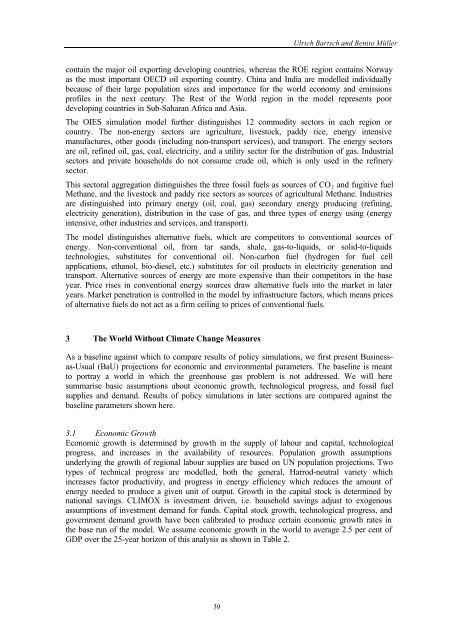sectoral economic costs and benefits of ghg mitigation - IPCC
sectoral economic costs and benefits of ghg mitigation - IPCC
sectoral economic costs and benefits of ghg mitigation - IPCC
You also want an ePaper? Increase the reach of your titles
YUMPU automatically turns print PDFs into web optimized ePapers that Google loves.
Ulrich Bartsch <strong>and</strong> Benito Müller<br />
contain the major oil exporting developing countries, whereas the ROE region contains Norway<br />
as the most important OECD oil exporting country. China <strong>and</strong> India are modelled individually<br />
because <strong>of</strong> their large population sizes <strong>and</strong> importance for the world economy <strong>and</strong> emissions<br />
pr<strong>of</strong>iles in the next century. The Rest <strong>of</strong> the World region in the model represents poor<br />
developing countries in Sub-Saharan Africa <strong>and</strong> Asia.<br />
The OIES simulation model further distinguishes 12 commodity sectors in each region or<br />
country. The non-energy sectors are agriculture, livestock, paddy rice, energy intensive<br />
manufactures, other goods (including non-transport services), <strong>and</strong> transport. The energy sectors<br />
are oil, refined oil, gas, coal, electricity, <strong>and</strong> a utility sector for the distribution <strong>of</strong> gas. Industrial<br />
sectors <strong>and</strong> private households do not consume crude oil, which is only used in the refinery<br />
sector.<br />
This <strong>sectoral</strong> aggregation distinguishes the three fossil fuels as sources <strong>of</strong> CO 2 <strong>and</strong> fugitive fuel<br />
Methane, <strong>and</strong> the livestock <strong>and</strong> paddy rice sectors as sources <strong>of</strong> agricultural Methane. Industries<br />
are distinguished into primary energy (oil, coal, gas) secondary energy producing (refining,<br />
electricity generation), distribution in the case <strong>of</strong> gas, <strong>and</strong> three types <strong>of</strong> energy using (energy<br />
intensive, other industries <strong>and</strong> services, <strong>and</strong> transport).<br />
The model distinguishes alternative fuels, which are competitors to conventional sources <strong>of</strong><br />
energy. Non-conventional oil, from tar s<strong>and</strong>s, shale, gas-to-liquids, or solid-to-liquids<br />
technologies, substitutes for conventional oil. Non-carbon fuel (hydrogen for fuel cell<br />
applications, ethanol, bio-diesel, etc.) substitutes for oil products in electricity generation <strong>and</strong><br />
transport. Alternative sources <strong>of</strong> energy are more expensive than their competitors in the base<br />
year. Price rises in conventional energy sources draw alternative fuels into the market in later<br />
years. Market penetration is controlled in the model by infrastructure factors, which means prices<br />
<strong>of</strong> alternative fuels do not act as a firm ceiling to prices <strong>of</strong> conventional fuels.<br />
3 The World Without Climate Change Measures<br />
As a baseline against which to compare results <strong>of</strong> policy simulations, we first present Businessas-Usual<br />
(BaU) projections for <strong>economic</strong> <strong>and</strong> environmental parameters. The baseline is meant<br />
to portray a world in which the greenhouse gas problem is not addressed. We will here<br />
summarise basic assumptions about <strong>economic</strong> growth, technological progress, <strong>and</strong> fossil fuel<br />
supplies <strong>and</strong> dem<strong>and</strong>. Results <strong>of</strong> policy simulations in later sections are compared against the<br />
baseline parameters shown here.<br />
3.1 Economic Growth<br />
Economic growth is determined by growth in the supply <strong>of</strong> labour <strong>and</strong> capital, technological<br />
progress, <strong>and</strong> increases in the availability <strong>of</strong> resources. Population growth assumptions<br />
underlying the growth <strong>of</strong> regional labour supplies are based on UN population projections. Two<br />
types <strong>of</strong> technical progress are modelled, both the general, Harrod-neutral variety which<br />
increases factor productivity, <strong>and</strong> progress in energy efficiency which reduces the amount <strong>of</strong><br />
energy needed to produce a given unit <strong>of</strong> output. Growth in the capital stock is determined by<br />
national savings. CLIMOX is investment driven, i.e. household savings adjust to exogenous<br />
assumptions <strong>of</strong> investment dem<strong>and</strong> for funds. Capital stock growth, technological progress, <strong>and</strong><br />
government dem<strong>and</strong> growth have been calibrated to produce certain <strong>economic</strong> growth rates in<br />
the base run <strong>of</strong> the model. We assume <strong>economic</strong> growth in the world to average 2.5 per cent <strong>of</strong><br />
GDP over the 25-year horizon <strong>of</strong> this analysis as shown in Table 2.<br />
39
















